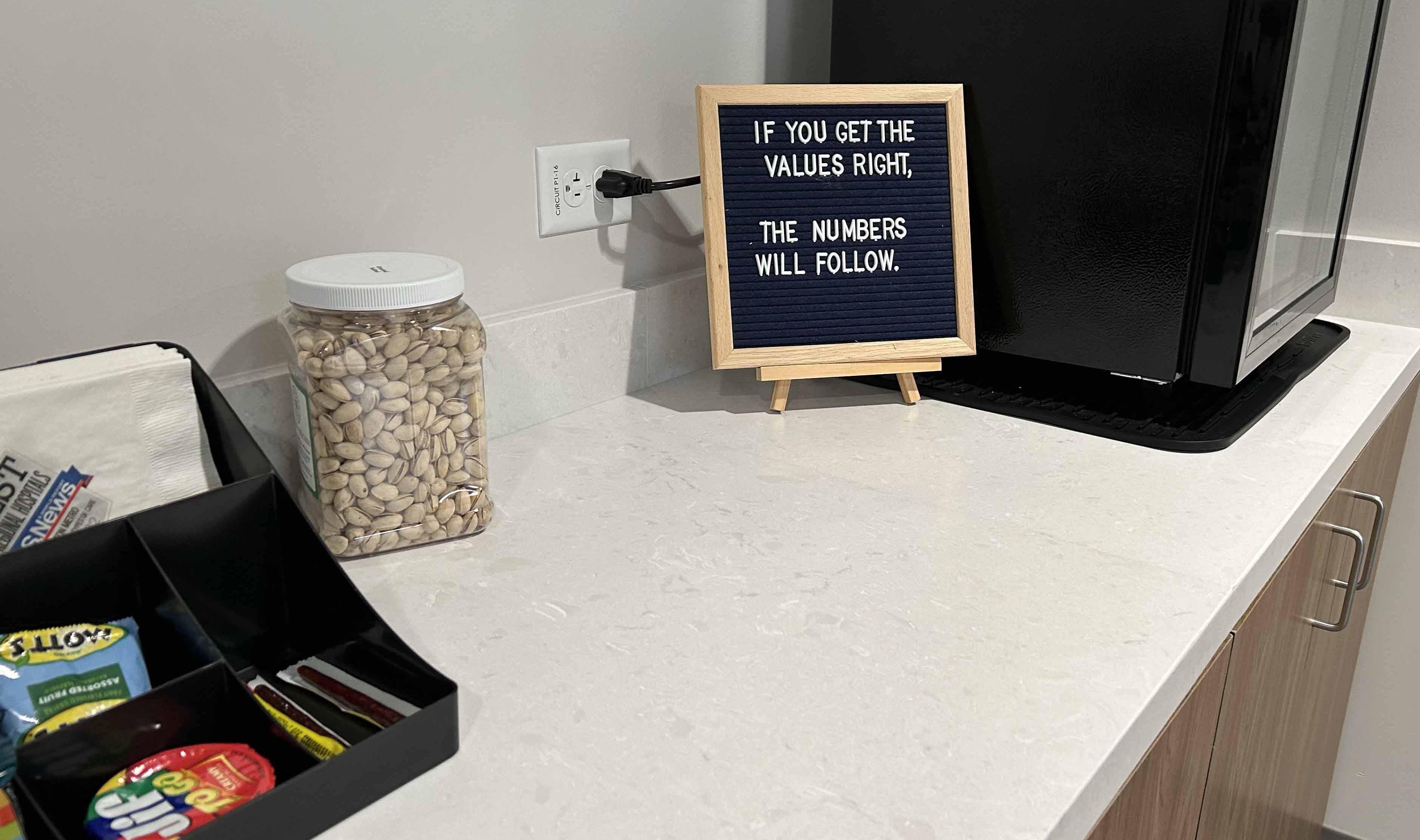
|
Where the Mission Meets the Margin
A Field Study of Organizational Communication at Houston Methodist Hospital |
     
|
|

|
Where the Mission Meets the Margin
A Field Study of Organizational Communication at Houston Methodist Hospital |
     
|
|
 |
Alexa Delenela is a senior attending Southwestern University in Georgetown, Texas. She is pursuing a major in Communication Studies and a double minor in Computer Science and Data Analytics. She has an extensive background in the tech field and only recently made the switch to majoring in Communication Studies. After graduation, Alexa plans on taking some time to work then attend law school. Currently, her end goal is to work in tech law and influence regulations surrounding new and upcoming technologies. |
During our time at Houston Methodist, we were able to observe and speak with a variety of people from different backgrounds and fields at Houston Methodist Willowbrook (HMWB) and "Downtown." The first, primary takeaway being discussed in this paper has to do with the overall culture of Houston Methodist. Their priorities include how they care for the patient and community beyond the clinical side, their I CARE and AIDET values, using data to guide their goals, and Christian practices. The second takeaway is how Houston Methodist brands themselves and the messaging they use in order to do so. The methods and actions taken may differ between the Willowbrook and Downtown locations; however, they both share common goals and similarities that will be detailed later on.
1. Values, Goals, and Culture
1.1 Patient Experience and Relationship
The number one stated priority of Houston Methodist (HM) is their patients, and this thoroughly shows in their practices and workplace culture. The biggest example is through their usage of Hospital Consumer Assessment of Healthcare Providers and Systems (HCAHPS) surveys and how they address provided concerns that emerge in the surveys. HCAHPS is an independent survey instrument administered in multiple hospitals. Houston Methodist specifically uses HCAHPS to gauge patient satisfaction and learn about any friction points that need to be fixed.
For example, previous HCAHPS survey results of HMWB patients showed that patients felt that their physicians were not communicating with each other or with them about what they did communicate to each other about. To address this, HMWB came up with a new practice of doing care team meetings about plans of care in the room with the patient to outwardly show their coordination to the patient. Even though such coordination had been happening behind the scenes, HMWB decided to demonstrate it to the patient to make this known to the patient and help said patient be informed about the hospital's collective plan for their health. Such practices lead to receptive and compliant patients, which benefits their experience and the work of physicians and other caregivers. Through this, it is evident that Houston Methodist takes patient satisfaction seriously and will make efforts to change pre-existing practices to ensure their current and future patients not only are cared for, but feel cared for.
Lobby of the flagship Houston Methodist Hospital. Photo by Bob BednarThis care can also be seen in the physical, "patient-facing" areas of the hospital for both Willowbrook and Downtown. The main lobbies of both locations do not strike the viewer as having a "hospital look" but are instead reminiscent of a hotel lobby. In fact, our tour guide for the Downtown location informed us that this design choice was intentional to make it a "soft space," contrasting it with the "hard spaces" such as patient rooms, operating rooms, etc. By this, he means a comfortable area for patients and especially their friends and family to have a "home away from home." In addition to this, Houston Methodist displays many art pieces in their hallways and has constant classical music playing, whether that be a live performance or over the speakers. This attentiveness to the arts reflects their idea of holistic healing, where care is not just physical, and creating a calming environment.
In relation to fostering a patient-centered environment, a seemingly contradicting aspect of Houston Methodist is their lack of an internal map or directory that would help visitors orient to the space. During our first tour of the Willowbrook campus, our tour guide mentioned that there is an external map of the whole campus to help people navigate to a particular building, but no internal floor plan to help people navigate once they are in the building. She stated that the reason for this is a preference by HMWB for patients and their families to look to HMWB employees to guide patients and visitors through the hospital. In this way, both parties are able to converse with each other and create a culture of connection. Through this connection, each patient has a personalized experience. However, the downside of this is visitor confusion in the scenario that no worker is available to guide them or if a visitor prefers to not have social contact as they move through the hospital.
Electronic directory at HMWB. Photo by Bob BednarWhile the patients within the hospital are important, Houston Methodist also seeks to build relationships with potential or past patients by contributing to the community and through events. By partnering with groups that the community already cares about, such as the Houston Astros, Houston Methodist can make an audience of people aware of their services. Additionally, Willowbrook, alongside the other Houston Methodist locations, hosts more local events, classes, and tours to help people become familiar with their campus and build relationships. This way, they ensure that people are familiar with Houston Methodist beyond the strictly clinical setting.
1.2 I CARE and AIDET
This consideration of patients continues to show through their I CARE values and AIDET practices. I CARE stands for Integrity, Compassion, Accountability, Respect, and Excellence. This acronym frequently appears throughout the physical signs in the hospital, on their website, in their internal slideshows, and is often mentioned in meetings and by those we spoke with. Even when it is not explicitly stated, it seems to be the undercurrent for all of the hospital's practices and kept in everyone's mind. Everyone working at the hospital is held to the I CARE standard and they all act in accordance with this, even through volunteer work. While many of the departments differ from each other, this acronym is one that they all strive for, and it performs a strong organizing force in the lives of everyone we met associated with the hospital. On the other hand, AIDET stands for Acknowledge, Introduce, Duration, Explanation, and Thank You. This acronym is primarily for caregivers to use while interacting with patients. While this acronym is not unique to Houston Methodist, it helps the patient feel heard and cared for.
1.3 Data Driven Decisions
As a student personally interested in data analytics, I noticed that in addition to making patient-focused decisions, Houston Methodist studies and utilizes data and statistics to orient their decisions. In one particular huddle, among the Capacity Command group, our research group was able to witness the handling of overall patient data. The numbers they cared most about were the number of discharges and the time patients spend in the hospital. Their overall goal is to keep the number of discharges high while limiting the time patients spend inside the hospital.
On one hand, increasing the number of discharges ensures more beds are available to patients and more people can be cared for. In addition, many patients benefit from being at home and not spending too much time in the hospital. On the other hand, there is a risk of seeing patients as numbers moving through a system instead of people, and prioritizing moving patients/numbers out of the hospital regardless of what their care needs might be. The goal of lessening the time people spend in the hospital can backfire into not entirely and holistically addressing their needs in favor of meeting this metric. In other words, there is a risk of the hospital becoming a factory for treatment, treating each person like an object on an assembly line that needs to get out the door.
While I feel the balance between patient needs and data was struck well at Houston Methodist, it is still a consideration that needs to be constantly held. It is beneficial, and reassuring, that data is held in high consideration for making decisions. Knowing these numbers and frequently discussing them is an important practice that contributes to high-level thinking and keeping the hospital running. However, the nature of data is to take away the details and nuances of each individual patient, essentially depersonalizing them, pointing to a potential friction point in the hospital's attempt to balance the mission and the margin.
1.4 The "Methodist" in Houston Methodist
One aspect of Houston Methodist that surprised me was how much they implemented Methodist values and the importance they put on spiritual life. All locations have a chapel and a statue of Jesus in them. In fact, for both the downtown and Willowbrook locations, the statue of Jesus is displayed prominently in the main lobby and stands out to those entering for the first time. This may seem odd in a hospital setting, but the Jesus statue present in all the hospitals in the system, titled "Jesus, The Great Physician," works asserts a continuity between Jesus as a healer and contemporary doctors.
There were also murals reminiscent of old Christianity at both locations portraying Jesus and Christianity alongside medicinal progress. Additionally, during our tour of the downtown location, I observed a few signs with verses from the Bible. Beyond what was present at physical spaces, Christianity can also be witnessed on the business side. The fact that Houston Methodist has a VP of Spiritual Care and Values Integration position and multiple chaplains shows that they place high importance on providing spiritual care alongside physical.
In most cases, references and practices associated with spirituality were broadly inclusive in their orientation and framed as spiritual vs. religious, such as the interfaith prayer that started the first standup meeting we attended, but the Environmental Services (EVS) huddle started with a prayer led by a Protestant Christian chaplain who asked the attendees for prayer requests as if we were in a church service for a specific denomination. This same chaplain delivered the morning blessing carried over the HMWB PA system. While some of these overt invocations of a specific faith tradition might be off-putting to people who are not Christians, all of these aspects paint a picture of Houston Methodist being true to its name as a religiously-affiliated hospital, in a more literal sense.
2. Branding and Messaging
2.1 Willowbrook Marketing
To summarize the Willowbrook Marketing team, they operate on a community level and focus their efforts on the region they serve. In terms of their external activities, the marketing team aims to increase awareness of services that most apply to their local community while being both high profit and high performance among potential "commercial" patients. For example, orthopedics (and thus the age group of 35 to 55) is highly emphasized in Willowbrook billboards and magazines since it meets the prior criteria.
In order to reach a wide audience, the marketing team's goal with advertisements is to evolve and grow by getting involved in newer spaces. This is especially important since Willowbrook does not have its own social media handle. Rather, Houston Methodist as a whole has one handle. Additionally, advertisements are not localized on websites and are instead general and corporate. One example of the team's efforts is their meeting and negotiation with a local newspaper called Community Impact. In this meeting, the HMWB marketing team aimed to make their events more visible to the local public by buying advertisement spaces in the Community Impact newspapers, but it was clear that this was a tactic that Corporate marketing and the centralized media buyer for HM might resist. This meeting also involved the marketing director for the new Cypress location, which shows the collaboration between the two regional hospital teams. This is especially interesting since the new Cypress hospital will technically take sections of the market that Willowbrook currently serves.
2.2 Corporate Marketing
In comparison to the Willowbrook marketing team, the corporate marketing team was more focused on the broader Houston Methodist brand. In that vein, they not only want to attract "commercial" patients (patients with commercial insurance who will pay negotiated fees for services, unlike Medicare and Medicaid patients) but also retain them for life. One way the team gauges consumer preference is by referring to monthly surveys asking about their preferred hospital brand. Regarding their own data, the team has different metrics depending on their goals. For example, they can measure engagement by looking at numbers such as time spent on an article or clicks on a digital advertisement. This metric, alongside others, helps Houston Methodist stay dynamic in their appeals to consumers and to position themselves towards their internal goals.
Consumers and potential patients are not the only audiences Houston Methodist must consider. Their national reputation is one of great importance as it influences recruitment, grants, affiliations, and more. To manage this, the team keeps a close eye on their national ranking in US News & World Report and other rank-based sites, and actively works to influence the reputation score by engaging physicians outside of the HM system. From there, they use these rankings to foster an image of Houston Methodist and increase their credibility.
One trait of Houston Methodist that heavily plays into these branding efforts and strategies is centralization. During our meeting with the team, this idea was emphasized multiple times. HM believes that by having one voice, their messages are stronger and more efficient. This is why, as stated previously, Houston Methodist has one social media handle for the whole entity rather than individual ones for each location. Instead of locations and departments working separately while being under the same, general brand, they all work together symbiotically and stay unified in their strategies and goals. An example of how they maintain this strategic alignment is through Marketing Leadership Team (MLT) meetings, which involve marketing managers from all campuses. By keeping everyone on the same page on a leadership level, especially for marketing, Houston Methodist maintains a singular, consistent voice to the public.
2.3 Overall
While the two marketing teams operate on different scales, there were still similarities between them. First and foremost is their common sentiment of being "not-for-profit, but also not for loss," which directly relates to the whole mission/margin dynamic. Unlike a traditional business, Houston Methodist is in a unique position where they must balance the human side of patient care with the reality of needing to make money. The marketing teams address this by advertising to the commercially insured. By doing this, they are able to use the money to support and care for everyone, especially those who use Medicare and Medicaid.
Another important goal they share is to build awareness of the Houston Methodist brand in the public eye. When people see advertisements, they are unlikely to need Houston Methodist's services at that moment. A member from the marketing team explains this by comparing their advertisements to Nike. Unlike a Nike advertisement, where you can act immediately the moment you see it to buy shoes, Houston Methodist aims to keep themselves top of mind now and for the future. Through this, anyone who eventually needs medical services will think of Houston Methodist first.
Conclusion
Our group's trip to visit and learn more about Houston Methodist was valuable and enriched my understanding of how Houston Methodist functions as an organization. It is clear to me that Houston Methodist as a whole, as well as the people we met, place high importance on their mission of serving patients. This consideration not only applies on the physician level but permeates the practices on the business and operations sides. Not only this, but learning how Houston Methodist works to stay ahead through their innovations and strategies was interesting to me on a personal level. Through their consistent cultures and values, as well as their planned and executed actions, it is clear to see that current and potential patients are front of mind at Houston Methodist.
     
|
|
Design © 2024 by Bob Bednar and Alexa Delenela
Contact: |